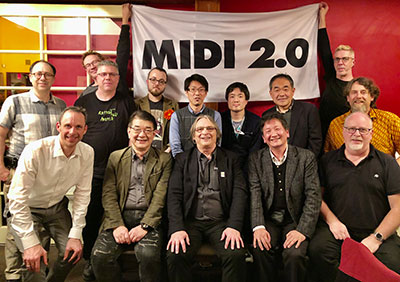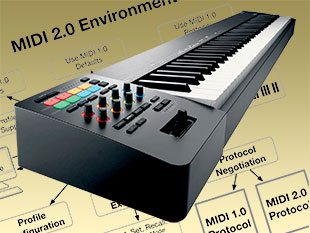![]() When it appeared in 1983, Midi changed my life – as it did for countless other keyboard players around the world. Like any revolution worthy of the name, its arrival wasn’t universally welcomed but it was unstoppable.
When it appeared in 1983, Midi changed my life – as it did for countless other keyboard players around the world. Like any revolution worthy of the name, its arrival wasn’t universally welcomed but it was unstoppable.
In the years since, Midi has become a music making mainstay, and is noe in the spotlight again.
‘This is the biggest update to Midi in 36 years,’ said Mike Kent of the Midi Manufacturers Association on the announcement of Midi 2.0 at the Anaheim Namm Show. ‘The specifications have been designed to add numerous new options to Midi while always keeping priority on a high level of backward compatibility with existing Midi devices.’
 Instigated by Sequential Circuits founder Dave Smith, whose Prophet 5 was the first Midi keyboard on the market when it appeared in 1978, Midi (the Musical Instrument Digital Interface) threw down the gauntlet to the proprietary interfaces that had, to that point, been the only means of connecting keyboards, drum machines and sequencers together as a music making system. While these unlocked new means of making music, they largely denied different manufacturers’ kit from being connected together.
Instigated by Sequential Circuits founder Dave Smith, whose Prophet 5 was the first Midi keyboard on the market when it appeared in 1978, Midi (the Musical Instrument Digital Interface) threw down the gauntlet to the proprietary interfaces that had, to that point, been the only means of connecting keyboards, drum machines and sequencers together as a music making system. While these unlocked new means of making music, they largely denied different manufacturers’ kit from being connected together.
If you had chosen a Roland Jupiter 8 on the strength of its sound, you could rule out adding an Oberheim DMX drum machine as a consenting partner. Once you’d chosen a keyboard, you were pretty much committed to using the same manufacturer’s drum sounds and sequencing interface.
As an indication of manufacturers’ prevailing proprietary attitude, let’s take Moog’s Open System as a starting point. With Moog having adopted a 1V/octave control voltage (CV) for pitch control and a negative-going 15V trigger or gate to signal note on/off (S-trig, presented on a two-pin Cinch/Jones plug) for interfacing its early mono synths, subsequent manufacturers’ systems, while retaining the 1V/octage CV, adopted a 3V positive trigger (V-trig, on a quarter-inch jack), drawing a line between themselves and the trailblazer.
Midi promised the freedom to mix and match, but required the wider industry to get behind it. Some were reluctant, but the Midi Manufacturers’ Association (MMA) founded by Oberheim founder Tom Oberheim, Roland founder Ikutaro Kakehashi and Sequential Circuits’ Smith, offered a way forward. Cautiously conversations began, the opportunities a shared standard might offer were explored, and a standard began to emerge.
Real proof that Midi would reward established manufacturers, rather than simply trading certain customers with other manufacturers, was the appearance of a new MI business area – third-party manufacturers offering Midi/CV interfaces, Midi routers and filters, Midi patch librarians, and Midi conversions for pre-Midi synths (like the one that Kenton Electronics did on my Roland Jupiter 8). We also got the first wave of Midi sequencing software, opening the door on a new way of composing, creating, recording and performing music, and was the precursor to the ubiquitous DAW.
With the industry on side, it was left to musicians with more traditional chops to deride the generation of ‘non-musicians’ it allowed to flourish.
The next chapter in Midi’s story saw the MMA hit a rough patch, with suggestions that some players were trying to ‘own’ Midi. But the dust settled and the wider landscape offered by a shared standard was revealed. In time, we got successive revisions of Midi including the General Midi subset. And now we’re offered the full Midi 2.0 update.
Enter Miidi 2.0
For me, the promise of backward compatibility mentioned by Mike Kent is essential to Midi 2.0’s success. In addition to keeping older spec equipment (and its owners) within the fold, it keeps the door open to older technology in future music and sound work. It would be a considerable loss to marginalise vintage and legacy equipment – there’s so much treasure there still to be mined. Some features of Midi 1.0 gear can also be ‘retrofitted’ with Midi 2.0 features.
Perhaps the defining aspect of Midi 2.0 is that it makes the conversation between Midi-connected kit a dialogue. Described by Kent as ‘fundamental paradigm shift’, it enables respective pieces of gear to establish for themselves what can pass between them. Having to determine this manually would, in my estimation, have severely compromised its use.
At its simplest, we now have Midi with auto-configuration (Profile Configuration and Property Exchange) alongside new DAW/web integration, increased resolution and expressiveness, and tighter timing through extended Midi messages – this will increase musical expression and per-note control. Jitter Reduction Timestamps will allow much tighter timing of all messages, including notes and the tempo clock.

In more detail, where Midi messages were previously passed from a transmitter to a receiver, Midi 2.0 is bi-directional – allowing devices to talk to each other and auto-configure themselves using new Capability Inquiries (Midi-CI) messages. They can also exchange information on functionality (key to backward compatibility) to establish when Midi 2.0 is supported and when it is limited to Midi 1.0 vocabulary.
Midi 2.0 re-visits the role of performance controllers, making them easier to use and increasing their scope to in excess of 32,000 parameters, including controls for individual notes. Moving up to 32-bit resolution is hoped to bring an ‘analogue feel’ to expression, permanently putting aside ‘zipper’ effects. New Note-On options add articulation control and precise note pitch alongside improved dynamic response (velocity). Major timing improvements can retroactively apply to control of Midi 1.0 devices.
Midi 2.0 Profiles can dynamically configure a device for specific applications, such as a synthesiser Profile mapping controls to keyboard parameters and a mixer Profile to faders and pan-pots, while a lighting controller Profile adopts dimmers. Where Profiles set up an entire device, Property Exchange messages provide specific, detailed information sharing and can discover, retrieve, and set everything a Midi 2.0 device needs to know about another Midi 2.0 device.
Midi 2.0 also has plenty of free opcodes to accommodate further specifications.
Midi 2.0 could never hope to repeat the revolution brought about by its predecessor. But the opportunity to rationalise it and take it forward into territory that could not previouslt be imagined nor technically achieved has proved irresistible. That it carries legacy Midi devices and software with it, and that it makes good provision for development are to be commended.
‘Manufacturers can now start creating products with confidence that they will work with not only with new Midi 2.0 gear, but with legacy Midi gear as well,’ said the MMA in a joint statement. ‘Furthermore, Roland introduced the A-88 MkII – the first Midi 2.0-ready controller keyboard. It realises Midi 2.0’s promise of greater expressiveness thanks to higher controller and velocity resolution, coupled with the ability to take advantage of Midi 2.0’s vastly extended range of controllers.’
In a past Fast-and-Wide blog marking 30 years of Midi I noted, ‘Today, if you’re a programmer, the Midi code is a bit of mess. But what else would you expect after 30 years of common ownership and extreme mission creep?’ Seven years down the line, with Midi 2.0, those expectations have been renewed.
See also:
Roland A-88MkII